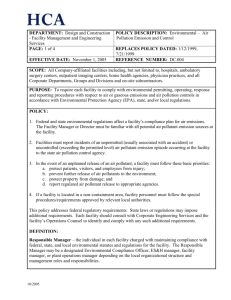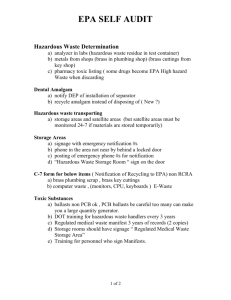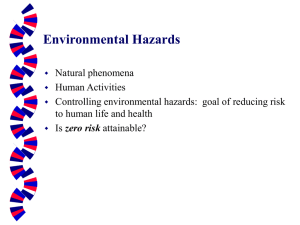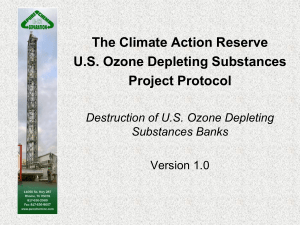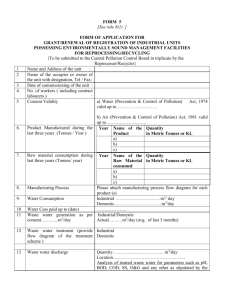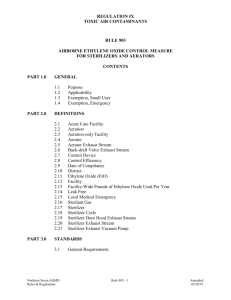Air Pollutant Emission and Control
advertisement
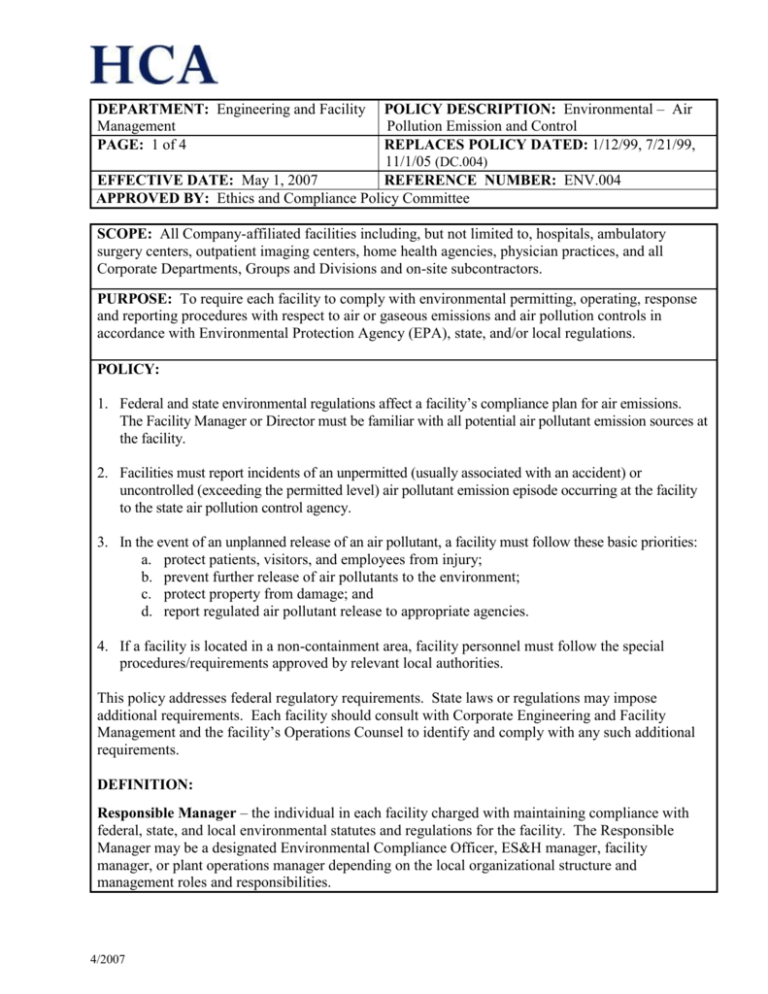
POLICY DESCRIPTION: Environmental – Air Pollution Emission and Control REPLACES POLICY DATED: 1/12/99, 7/21/99, 11/1/05 (DC.004) EFFECTIVE DATE: May 1, 2007 REFERENCE NUMBER: ENV.004 APPROVED BY: Ethics and Compliance Policy Committee DEPARTMENT: Engineering and Facility Management PAGE: 1 of 4 SCOPE: All Company-affiliated facilities including, but not limited to, hospitals, ambulatory surgery centers, outpatient imaging centers, home health agencies, physician practices, and all Corporate Departments, Groups and Divisions and on-site subcontractors. PURPOSE: To require each facility to comply with environmental permitting, operating, response and reporting procedures with respect to air or gaseous emissions and air pollution controls in accordance with Environmental Protection Agency (EPA), state, and/or local regulations. POLICY: 1. Federal and state environmental regulations affect a facility’s compliance plan for air emissions. The Facility Manager or Director must be familiar with all potential air pollutant emission sources at the facility. 2. Facilities must report incidents of an unpermitted (usually associated with an accident) or uncontrolled (exceeding the permitted level) air pollutant emission episode occurring at the facility to the state air pollution control agency. 3. In the event of an unplanned release of an air pollutant, a facility must follow these basic priorities: a. protect patients, visitors, and employees from injury; b. prevent further release of air pollutants to the environment; c. protect property from damage; and d. report regulated air pollutant release to appropriate agencies. 4. If a facility is located in a non-containment area, facility personnel must follow the special procedures/requirements approved by relevant local authorities. This policy addresses federal regulatory requirements. State laws or regulations may impose additional requirements. Each facility should consult with Corporate Engineering and Facility Management and the facility’s Operations Counsel to identify and comply with any such additional requirements. DEFINITION: Responsible Manager – the individual in each facility charged with maintaining compliance with federal, state, and local environmental statutes and regulations for the facility. The Responsible Manager may be a designated Environmental Compliance Officer, ES&H manager, facility manager, or plant operations manager depending on the local organizational structure and management roles and responsibilities. 4/2007 POLICY DESCRIPTION: Environmental – Air Pollution Emission and Control REPLACES POLICY DATED: 1/12/99, 7/21/99, 11/1/05 (DC.004) EFFECTIVE DATE: May 1, 2007 REFERENCE NUMBER: ENV.004 APPROVED BY: Ethics and Compliance Policy Committee DEPARTMENT: Engineering and Facility Management PAGE: 2 of 4 PROCEDURE: 1. The Responsible Manager shall review health care operations requiring compliance with air emissions and air pollution control including: a. on-site incineration of biomedical waste; b. ethylene oxide sterilization; c. toxic air emissions; d. refrigeration chemical management; e. boiler operation; and f. emergency generator operation. 2. The Responsible Manger shall be familiar with air pollution emission incidents that may have federal, state, or local reporting requirements including: a. fire or explosion; b. toxic gaseous chemical (e.g., ethylene oxide, chlorine) leak; c. incinerator malfunction or improper operation of incinerator; d. improper dust suppression or isolation during construction or renovation activities; e. deficiency in chemical storage or chemical handling practice; and f. malfunction of any air pollution control equipment (scrubber or catalytic converter). 3. The Responsible Manager or Director must review the heat input (in terms of million BTU/hour) of the gas- or oil-fired boiler against the state regulatory threshold levels to determine whether an air pollution control permit is needed. Depending on the heat input capacity rating of boilers, a facility may be subject to air emissions permitting requirements. 4. The Responsible Manager must determine if a facility uses an incinerator for biomedical waste treatment. The Responsible Manger must keep a medical waste incinerator permit, a permit exemption, or proof of permit-by-rule. Reporting requirements and procedures for uncontrolled air pollutant emissions from the incinerator are usually stated in the air permit. 5. The Responsible Manager must ensure that asbestos fibers are not released. Asbestos fiber releases that occur during a fire, flood, or asbestos abatement project must be reported to regulatory authorities and should be handled jointly by an asbestos abatement contractor and facility personnel. 6. The Responsible Manager must be aware that EPA has classified ethylene oxide as an “extremely hazardous air pollutant.” OSHA has classified ethylene oxide as a “highly hazardous chemical.” By definition, this chemical causes death, injury, serious adverse effects to human health and the environment if it is accidentally released. All safety procedures recommended by the sterilizer 4/2007 POLICY DESCRIPTION: Environmental – Air Pollution Emission and Control REPLACES POLICY DATED: 1/12/99, 7/21/99, 11/1/05 (DC.004) EFFECTIVE DATE: May 1, 2007 REFERENCE NUMBER: ENV.004 APPROVED BY: Ethics and Compliance Policy Committee DEPARTMENT: Engineering and Facility Management PAGE: 3 of 4 manufacturer must be followed. In some states, a catalytic converter is required to abate ethylene oxide sterilizer exhaust. Never disengage any air pollution control device. Do not exhaust the ethylene oxide sterilizer off-gas to sewer. Major elements requiring routine inspection and regular maintenance include: a. tank/cylinder storage room, and loading room; b. ethylene oxide sterilizer; c. detection instruments and alarm system; d. emission control equipment; e. duct work and exhaust piping; and f. health and safety equipment and material supply. 7. The Responsible Manager must review the list of 189 chemicals classified by the EPA as hazardous air pollutants and ensure the facility is operating within the established limits and reporting requirements. Each facility must review the list of chemicals used at the facility against the regulatory reporting limits. 8. The Responsible Manger or designee must make annual notification to federal and/or state authorities for facilities manufacturing, emitting, or possessing hazardous air pollutants. 9. The Responsible Manager must ensure compliance with SARA Title III (Section 304) which requires a facility to provide a notification of any release of an Extremely Hazardous Substance (EHS) or Comprehensive Environmental Response, Compensation and Liability Act (CERCLA) hazardous substance in an amount equal to or greater than the reportable quantity (RQ) to the appropriate authorities. 10. The Responsible Manager may be required by the EPA to file a Risk Management Plan if a facility stores more than 18,000 gallons of propane. A Risk Management Plan must be updated and certified every five years. Preparation of a Risk Management plan should be coordinated with the Corporate Engineering and Facility Management Department. 11. Refrigerants, including chlorofluorocarbons (CFCs) and hydrochlorofluorocarbons (HCFC), are used in chillers, air conditioners, ice makers, and refrigerators. CFC is also used as a diluent in ethylene oxide sterilizers. Clean Air Act Amendments (CAAA) prohibit the release of CFCs to the atmosphere and require use of these substances be phased out. Each facility must use EPA-certified technicians to service equipment containing CFC and HCFC refrigerants. A facility may store CFCs in a secure outdoor location; or in a properly lighted, forced-air ventilated room, or a continuously ventilated room provided that: a. the location is locked at all times with controlled access and there is a proper sign at the entrance; 4/2007 POLICY DESCRIPTION: Environmental – Air Pollution Emission and Control REPLACES POLICY DATED: 1/12/99, 7/21/99, 11/1/05 (DC.004) EFFECTIVE DATE: May 1, 2007 REFERENCE NUMBER: ENV.004 APPROVED BY: Ethics and Compliance Policy Committee DEPARTMENT: Engineering and Facility Management PAGE: 4 of 4 b. a respirator is located outside the room at a visible place; c. forced-air venting is provided before personnel enter the location (manual switch located outside the entrance); d. pure and spent refrigerants are separated and properly labeled; e. inventory is maintained and the room is inspected bi-weekly; and f. if refrigerants are co-stored with hazardous materials, the stricter health and safety requirements are observed. REFERENCES: EPA regulation: SARA Title III Section 302 29 CFR 1910.109 and 119, OSHA Process Safety Management of Highly Hazardous Chemicals Federal EPA Clean Air Act Amendments of 1990 HCA CFC Questions and Answers (see attached) 4/2007 AIR POLLUTION EMISSION AND CONTROL CHLOROFLUOROCARBON (CFC) QUESTIONS AND ANSWERS 1. Do I need to buy recovery equipment to comply with the 1990 Clean Air Act Amendment (CAAA)? Yes, if your facility staff will be servicing any CFC-containing equipment. The person servicing such equipment must not allow refrigerant to be vented to the atmosphere. This is accomplished by connecting a refrigerant recovery device to the equipment and withdrawing the refrigerant into storage tank(s) while the equipment is serviced. The alternative is to contract with a vendor for all maintenance of CFC-containing equipment. You must ensure that the contractor utilizes a recovery device to prohibit venting of CFC to the atmosphere. Historically, facility maintenance personnel maintained small equipment such as through-wall A/C units, ice machines, etc., but contract for maintenance of chillers and large DX equipment. Now, facilities must either re-think their policy on in-house maintenance or purchase a recovery device (approximate cost $1,700). If a recovery device is to be purchased, units from national vendors such as Trane™ or Carrier™ are recommended. 2. Do I need to install a high efficiency purge on my chiller(s)? Yes, this is required in chillers using R-11 refrigerants only. If this has not already occurred or you have questions, please contact the HCA Engineering and Facility Management Department for information and support. 3. Should I have facility personnel attend refrigeration equipment/maintenance seminars to obtain a refrigerant handling certification now? You are required to ensure personnel who perform maintenance on CFC-containing equipment are properly trained and certified by EPA. Have your staff enroll only in those certification or training programs approved by the EPA or your state or local authority. 4. Should I assign facility personnel to service refrigeration units? Only if you have a recovery device and have trained certified staff. Otherwise, you need to retain a qualified contractor to perform maintenance. During emergency maintenance, your staff or service contractor may respond as necessary. Release of CFC during an emergency is reportable to the authority having jurisdiction (i.e., EPA or state air pollution control office). 2/2007 Attachment to ENV.004 Page 1 of 2 5. Do I need to sign a Hazardous Waste Manifest when I remove a shipment of spent refrigerant? It depends on the final destination of the shipment. If the shipment is to be recycled, a receipt or invoice indicating the type, quantity, date of removal from the facility and the person receiving the shipment should suffice. If the shipment is for any purpose other than transfer to another company facility or for recycling, the shipment is classified as a hazardous waste. The shipment must then comply with all hazardous waste regulations, and be accompanied by a Hazardous Waste Manifest. 6. What should I do to plan for the phase-out of CFCs? a. If you have major chilling equipment which uses a CFC-type refrigerant (R-11, R-12, R-113, R500, etc.), contact HCA Engineering and Facility Management personnel (listed below) to insure that your facility’s equipment is included in the corporate CFC Compliance Phase-Out Replacement Program. b. Do not dispose of any CFC-type refrigerant (R-11, R-12, R-113, R-500, etc.). If you are removing equipment which uses CFC-type refrigerant or if the refrigerant becomes contaminated, contact HCA Engineering and Facility Management Department for recovery and reclamation support. c. If you need to acquire a CFC-type refrigerant, contact the HCA Engineering and Facility Management Department for availability of refrigerant under the corporate program. 7. How do I properly store CFCs at my facility? You may store CFCs in a secure outdoor location or in a properly lighted, forced-air ventilated room (e.g., existing hazardous material storage room) provided that: a. the location is locked at all times with controlled access and a proper sign at the entrance; b. a respirator is located outside the room at a visible place; c. forced-air venting is provided before personnel enter the location (manual switch located outside the entrance); d. pure and spent refrigerants are separated and properly labeled; e. inventory is maintained and the room is inspected bi-weekly; and f. if refrigerants are co-stored with hazardous materials, the stricter health and safety requirements are observed. 8. What should I do about the CFCs used in my Ethylene Oxide (ETO) sterilizer? Many ETO sterilizers use a mixture that is 88% CFC and 12% pure ETO. Technically, the CFC used is a diluent, not a refrigerant and therefore not subject to the CAAA (subject to change). You should plan for replacing the 88/12 sterilizer with a 100% ETO type when the sterilizer is due for replacement. If a compatible replacement for CFC becomes available, you should consider switching to the new diluent until the (88/12) sterlizer is due for replacement. 2/2007 Attachment to ENV.004 Page 2 of 2
